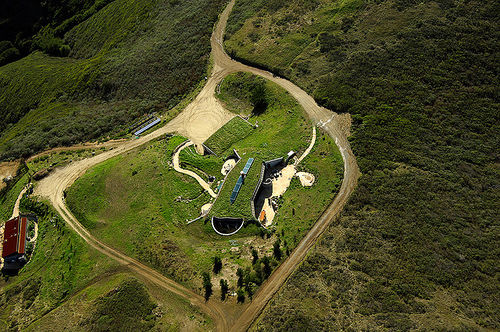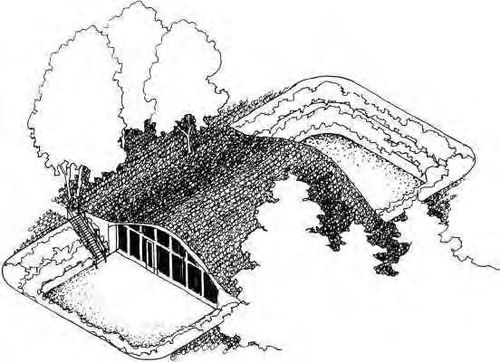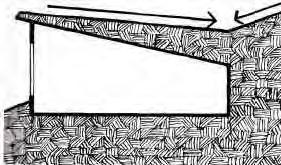Underground Housing: Difference between revisions
Jump to navigation
Jump to search
(typo) |
(resized image, added text) |
||
| (22 intermediate revisions by 6 users not shown) | |||
| Line 1: | Line 1: | ||
[[File:Earthsheleteredhome.jpg|500px|thumb|right|Earth sheltered home in Big Sur, California]] | |||
''' | |||
<blockquote><center>''"In a hole in the ground lived a hobbit.<br>Not a nasty, dirty, wet hole, filled with the ends of worms and an oozy smell,<br>nor yet a dry, bare, sandy hole with nothing in it to sit down on or eat:<br>it was a hobbit-hole, and that means comfort."''</center></blockquote> | <blockquote><center>''"In a hole in the ground lived a hobbit.<br>Not a nasty, dirty, wet hole, filled with the ends of worms and an oozy smell,<br>nor yet a dry, bare, sandy hole with nothing in it to sit down on or eat:<br>it was a hobbit-hole, and that means comfort."''</center></blockquote> | ||
''' | |||
[[File:Underground house for flat land.jpeg|thumb|right|500px|thumb|right|"Underground house for flat land"]] | |||
==Advantages== | |||
Underground homes have several advantages over homes built above the ground: | |||
* There is no need to lay a foundation, which saves a huge amount of labour and material | * There is no need to lay a foundation, which saves a huge amount of labour and material | ||
* The walls are earth, so that saves a lot more building material | * The walls are earth, so that saves a lot more building material | ||
* The thermal mass effect of the earth stabilizes the temperature. Earth cools and heats more slowly than the surrounding air. If you dig 2m (6 foot | * The thermal mass effect of the earth stabilizes the temperature. Earth cools and heats more slowly than the surrounding air. If you dig 2m (6 foot 6 inches) into the ground, the temperature is always - day and night, summer and winter - steady at that climate's average. A well-designed underground home should need no energy for heating or cooling | ||
* They are easy to build. | * They are easy to build. | ||
* They are unaffected by wind | * They are unaffected by wind, hail and hurricanes | ||
* Pipes are not exposed to atmospheric temperature and don't freeze | |||
* They require little maintenance | * They require little maintenance | ||
* They are soundproof | * They are soundproof and relatively fireproof | ||
* It can be complemented with a greenhouse that takes advantage of the heat already there (e.g. greenhouse-facing kitchen) | |||
Please see the page for [[Malcolm_Wells|Malcolm Wells]] for one architect's underground houses. | |||
[[File:How not to build an underground house.jpeg|thumb|right|400px|thumb|right|"How '''not''' to build an underground house!"]] | |||
==Underground Greenhouse== | |||
Greenhouses in cold climates must retain moderate temperatures for year-round growing, therefore [[Earth Sheltered Greenhouse|underground greenhouses]] are useful for temperature stabilization (see: [[Walipini]]). | |||
== | ==Mike Oehler's methods== | ||
Information about Mike Oehler's methods was removed after OSE received a ''Cease and Desist'' letter from the author based on copyright. -MJ 2/17/15 | |||
==Linkfest== | |||
* [http://www.earthshelter.com/ Performance Building Systems, Inc.] | |||
* [http://www.underground-homes.com/ Underground Homes] | |||
* [http://www.subsurfacebuildings.com SubsurfaceBuildings.com] | |||
* [http://williamlishman.com/underground-architecture/ Bill Lishman's underground domes], also [http://www.treehugger.com/files/2009/09/bill-lishmans-underground-dome-home.php featured on Treehugger]; built with [[ferrocement]] and then reburied. | |||
* Wikipedia: [http://en.wikipedia.org/wiki/Underground_living Underground Living] | |||
* [http://www.culturalconservers.org/library/171-180-earth-sheltered-housing.pdf "Earth-Sheltered Housing"], Washington Energy Extension Service (1984) | |||
* [http://www.undergroundhomesgazette.com/ Underground Homes Gazette] Articles and info about underground and earth sheltered housing. | |||
* Treehugger: [http://www.treehugger.com/green-architecture/green-magic-homes-are-probably-neither.html "Here's the dirt on a prefabricated plastic earth sheltered home design you can buy off the shelf"] | |||
* Pictures: [http://www.swansonarchitects.com/wp-content/uploads/2009/01/sustainable_green_architecture_eco_friendly-earth_sheltered_home_thumb.jpg Ziggurat-type] | |||
[[Category:Housing and construction]] | |||
Latest revision as of 01:32, 6 August 2016
"In a hole in the ground lived a hobbit.
Not a nasty, dirty, wet hole, filled with the ends of worms and an oozy smell,
nor yet a dry, bare, sandy hole with nothing in it to sit down on or eat:
it was a hobbit-hole, and that means comfort."
Advantages
Underground homes have several advantages over homes built above the ground:
- There is no need to lay a foundation, which saves a huge amount of labour and material
- The walls are earth, so that saves a lot more building material
- The thermal mass effect of the earth stabilizes the temperature. Earth cools and heats more slowly than the surrounding air. If you dig 2m (6 foot 6 inches) into the ground, the temperature is always - day and night, summer and winter - steady at that climate's average. A well-designed underground home should need no energy for heating or cooling
- They are easy to build.
- They are unaffected by wind, hail and hurricanes
- Pipes are not exposed to atmospheric temperature and don't freeze
- They require little maintenance
- They are soundproof and relatively fireproof
- It can be complemented with a greenhouse that takes advantage of the heat already there (e.g. greenhouse-facing kitchen)
Please see the page for Malcolm Wells for one architect's underground houses.
Underground Greenhouse
Greenhouses in cold climates must retain moderate temperatures for year-round growing, therefore underground greenhouses are useful for temperature stabilization (see: Walipini).
Mike Oehler's methods
Information about Mike Oehler's methods was removed after OSE received a Cease and Desist letter from the author based on copyright. -MJ 2/17/15
Linkfest
- Performance Building Systems, Inc.
- Underground Homes
- SubsurfaceBuildings.com
- Bill Lishman's underground domes, also featured on Treehugger; built with ferrocement and then reburied.
- Wikipedia: Underground Living
- "Earth-Sheltered Housing", Washington Energy Extension Service (1984)
- Underground Homes Gazette Articles and info about underground and earth sheltered housing.
- Treehugger: "Here's the dirt on a prefabricated plastic earth sheltered home design you can buy off the shelf"
- Pictures: Ziggurat-type


